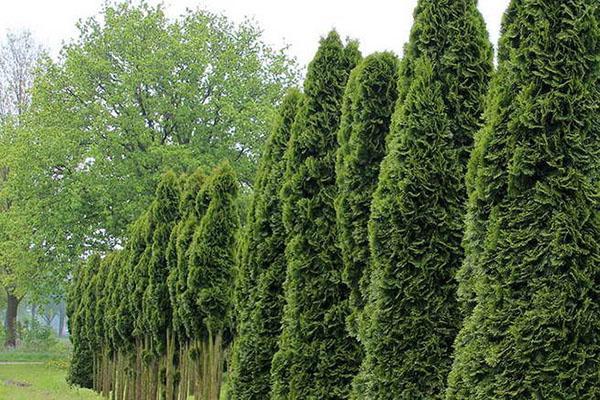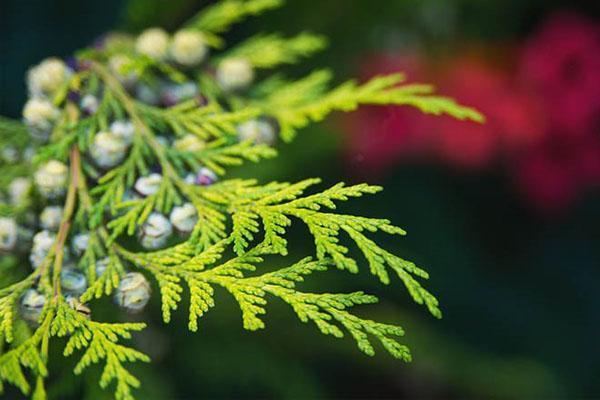What medicinal properties of thuja are known to us
 The healing properties of thuja have been known to the world for a long time. The Indians in America used a decoction of pine needles and wood for the prevention of infectious diseases, getting rid of rheumatism and other diseases of the joints, muscles and blood vessels. In Europe, during the Middle Ages, thuja was called the "tree of life": decoctions and oils of this evergreen plant treated many infectious diseases. And in the 18th century, Samuel Hahnemann, the founder of homeopathy, described the healing properties of thuja and the recipes for medicinal preparations to which it was added. Currently, interest in traditional medicine is growing, and thuja, known for its beneficial qualities, is included in a variety of medicines: antibacterial and antifungal drugs, relieving swelling, pain and fatigue, treating joints, bones, blood vessels and muscles, improving the functioning of internal organs.
The healing properties of thuja have been known to the world for a long time. The Indians in America used a decoction of pine needles and wood for the prevention of infectious diseases, getting rid of rheumatism and other diseases of the joints, muscles and blood vessels. In Europe, during the Middle Ages, thuja was called the "tree of life": decoctions and oils of this evergreen plant treated many infectious diseases. And in the 18th century, Samuel Hahnemann, the founder of homeopathy, described the healing properties of thuja and the recipes for medicinal preparations to which it was added. Currently, interest in traditional medicine is growing, and thuja, known for its beneficial qualities, is included in a variety of medicines: antibacterial and antifungal drugs, relieving swelling, pain and fatigue, treating joints, bones, blood vessels and muscles, improving the functioning of internal organs.
Thuja benefit and harm to humans

- resins;
- aromadendren (has anti-inflammatory effect);
- pentoxifylline (has a vasodilating property);
- sesquiterpene alcohol (opens the bronchi)
- flavonoids (affect the activity of enzymes);
- ascorbic and unique thuic acid, tannin (known for its tonic properties);
- tannins (anti-inflammatory and hemostatic properties);
- glycosides and saponins (antiarrhythmic action);
- essential oil.
In addition, thuja produces phytoncides - bioactive substances that contribute to the destruction of harmful microorganisms (fungi, microbes, viruses) and the production of useful ones. Therefore, walking among coniferous trees is very beneficial for health. Young shoots of needles contain many vitamins and minerals necessary for the body.
Tuyu is classified as a low-poisonous plant. Before using products from this coniferous tree, consult a specialist!
 The composition of the ether thuja oil includes thujone - a neurotropic poison, an overdose of which causes a disorder of the nervous system, hallucinations, a change in the perception of the world (for example, a sharp change in color), seizures and partial damage to brain cells.
The composition of the ether thuja oil includes thujone - a neurotropic poison, an overdose of which causes a disorder of the nervous system, hallucinations, a change in the perception of the world (for example, a sharp change in color), seizures and partial damage to brain cells.
Thuillon is one of the most important ingredients in absinthe ("Green Fairy"). The famous Dutch artist Van Gogh at one time was fond of absinthe, which caused a change in the perception of color in the world. This is noticeable if we consider the series of paintings by Van Gogh, where everything is presented exclusively in yellow tones.
Pregnant women should also not get too carried away with essential thuja oils, because thujone also has an abortion effect. However, with the correct dosage, thujone is not only not harmful, but also beneficial to human health.
The following are the maximum allowable values for thujone content for different products:
- food - up to 0.5 mg / 1 kg;
- alcoholic beverages - up to 5 mg / 1 kg;
- spirits - up to 10 mg / 1 kg;
- soft drinks - up to 0.5 mg / 1 kg;
- ointments, oils and creams - up to 4% content.
Thuja: useful properties and contraindications
 Thuja is one of the few plants with such a wide range of effects. This evergreen plant is used to make the following medicines:
Thuja is one of the few plants with such a wide range of effects. This evergreen plant is used to make the following medicines:
- tonic;
- immune-strengthening;
- antiseptic;
- sedatives;
- hemostatic;
- anti-inflammatory;
- antirheumatic;
- regenerative;
- strengthening;
- antiallergic;
- diuretics;
- anticarcinogenic;
- antiviral;
- antifungal;
- diuretics;
- nutritious.
The trees themselves produce antimicrobial agents. Thuja helps with coughs, inflammation, fatigue - just breathe them in pine air!
Read the instructions for use before using thuja medicines and consult your doctor. Due to the specific thujone toxin contained in them and other active substances, they are contraindicated for pregnant and lactating women, young children, with personal intolerance to certain components of the drug or allergies to them, epilepsy, excessive skin sensitivity.
Thuja tincture
 Thuja tincture is an old but proven remedy. It is effectively used for various diseases, it is easy to store, because the tincture retains its beneficial properties for a long time.
Thuja tincture is an old but proven remedy. It is effectively used for various diseases, it is easy to store, because the tincture retains its beneficial properties for a long time.
Application
Tincture is an almost universal remedy for many ailments. The following describes how to use it, for what problems and in what doses:
- Internally: 10-15 drops of tincture per 50 ml of water half an hour before or one hour after meals, 3-4 times every day. Consume within a month. If it does not help, the course must be repeated after a two-week break. It is used as a diuretic, expectorant, choleretic, antiseptic, anti-inflammatory, antifungal agent, as well as for bleeding in the gastrointestinal tract, urolithiasis, bronchial asthma, kidney and liver diseases, venereal diseases.
- Outwardly: lubricate the problem area twice a day until complete recovery. It relieves the thuja tincture from warts, acne and papillomas. Helps with inflammation of the gums, skin rashes, frostbite, inflammation of the hair follicles, lupus erythematosus, gout, rheumatism.
Manufacturing
 Such a folk remedy can be made at home. All ingredients are easy to find on your own, or to purchase. There are two types of thuja tincture: alcohol and vodka.
Such a folk remedy can be made at home. All ingredients are easy to find on your own, or to purchase. There are two types of thuja tincture: alcohol and vodka.
Raw materials can be harvested in forests (from May to September), grown independently or purchased from hands. If you live in an arid region, harvest is best done in mid-August. Most of all useful substances in young trees and shoots.
To prepare the tincture, you will need thuja needles, shoots or cones, the healing properties of which are preserved even after drying and rinsing.
Take 30 grams of finely chopped needles or cones, 200 ml of alcohol (or vodka), pour the mixture into a ceramic container, close tightly and leave in a warm place. Insist 2 weeks, shaking occasionally.
Thuja decoctions
 Herbal decoctions are widely used as medicines. Thuja is especially popular among conifers: medicinal properties in folk medicine have been known for a long time.
Herbal decoctions are widely used as medicines. Thuja is especially popular among conifers: medicinal properties in folk medicine have been known for a long time.
It is enough just to brew chopped needles, cones or thuja wood with boiling water. Can be combined with parts of other plants (e.g. buds birch). Decoctions are a good disinfecting, expectorant and healing agent.
Each part of the "tree of life" has beneficial qualities. Thuja wood, the use of which is found in oils, decoctions and ointments, helps to saturate the body with vitamins.
Oils
 Thuja oils are divided into several types, depending on the purpose:
Thuja oils are divided into several types, depending on the purpose:
- essential oil;
- homeopathic (can be buried in the throat and nose);
- aromatic oils.
Essential oils are allowed only for spot application (for example, to get rid of papillomas), since this is an ultra-strong healing agent.
Homeopathic oils have a wide range of applications: for diseases of the respiratory system (sinusitis, bronchitis, asthma), rheumatism and varicose veins, adenoids, skin diseases (lichen, itching, warts, eczema, papillomas), for normalizing digestion and the genitourinary system, cleansing the body of toxins , wound healing.
Aromatic oils relieve fatigue, soothe, increase concentration, and are used to prevent colds and flu.
The various medicinal properties of thuja determine the return of medical interest in this plant. You can even make a medicine from needles, seedlings, cones or bark at home. The main thing is to choose the right concentration.
It will be interesting to try the infusion of decoction
Good day ! A wonderful article and not even commercial as far as I understand. But here is the question for you, dear experts. I live in my own house and have a garden plot. In 2016, I planted thuja cuttings and 50% of them started and, as they say, conifers are pleasing to the eye. Yesterday I literally came across an article describing trees and their harm to humans and somehow it became uncomfortable, I thought to get rid of three seedlings (two of them grow under the window). Khayut Tuyu, birch, aspen at the same time, supposedly these trees bring death to their owners and are recommended to take them out of the site and out of sight. Please explain how this can be? With respect and hope for a qualified explanation of the dangers of the Tui tree growing on a personal plot, and even under the window.
I also heard and read a lot about the fact that it is absolutely forbidden to plant thuja near the house. I don’t know if I can give you a really qualified answer. I do not have an academic degree in this area. And, unfortunately (or fortunately), I do not possess any paranormal powers. I can only express my personal opinion and, so to speak, give an example from my personal life.
Long ago, when I was still a child, two thujas grew near our house, right almost under the windows, just a couple of meters from them, and another one in the backyard. They were planted by my mother, and the trees were already almost as tall as a house, when someone also told her that it was impossible to plant. So two of the three trees were cut down, but they decided to leave one, the farther one. And now many years have passed, we (both children and grandchildren, almost all even) have grown up, and our beautiful thuja is still alive and pleases us and our mother, who is also more than a dozen years old. Only the lower branches were cut off so that you could walk along the path that was just below it. Now this thuja for us is like a symbol of the parental home, its top serves as a real beacon, because you can see it from afar.
Has thuja influenced our lives? Hard to tell. As in every family, there were both joys and sorrows, but in general, everything is not so bad. And certainly not as bad as they say. And for what was bad, I think it's stupid to blame the tree. So my personal opinion is that thuja has much more benefit than harm. I don’t want to list the useful properties described in this article, but what is the coniferous aroma alone ... I would also gladly plant thuja, birch, and pine. Rather, even planted already, but for some reason none of them took root. Maybe the soil is not suitable ... And if they grow here and feel great, then let them live for themselves, please the eye and purify the air. The only thing is that if they are very close to the house, then it is better to transplant, while they are still small. Adult thujas are simply huge, and their root system can damage the foundation. I hope I didn't tire you with such a long answer.